Sony DSC-M1: Good Video, Disappointing Pictures
by Stephen Caston on June 20, 2005 12:05 AM EST- Posted in
- Digital Camera
The Design: Sony DSC-M1
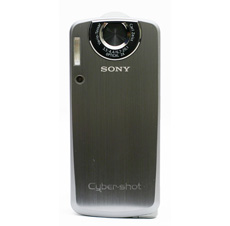 |
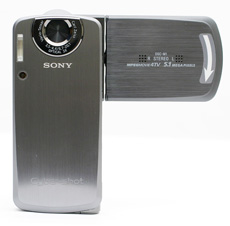 |
| Click images to enlarge. | |
The front of the M1 features a 3x Carl Zeiss lens capable of a 38-114mm optical zoom (35mm equivalent). The built-in flash can be found just to the left of the lens. Because of its small size, the output is significantly less than average (1.0 - 5.9' at wide angle). The AF-assist/self-timer lamp is located just below the built-in flash. From this angle, we can also see two microphones on the back of the LCD panel, which give the M1 the ability to record stereo audio.
On the back of the M1 is the 2.5" LCD monitor, which contains 123K pixels and can rotate a full 270º. On the left side of the LCD are three buttons. The Photo and Movie buttons can be used as an alternative to the Photo/Movie buttons in the main control area. They also act as back/forward buttons when viewing images and movies. The middle button serves to start/pause video during playback. To the right of the LCD monitor is the speaker that plays back audio from recorded movie clips. Directly above the speaker is the slot for the Memory Stick Duo flash card. Just to the right of the word "Pro" is a tiny access lamp, which illuminates while the camera is writing data to the card. Starting at the upper right, we can see the Reset button and three indicator lamps. Each lamp will illuminate according to the current status of the camera: charging, Record mode, or Playback mode. The Mode button allows you to select the camera's mode from Record or Playback. Below the rotating LCD monitor are the main controls for the camera. Sony's dedication to video is apparent on the M1 through the inclusion of both a photo and movie shutter button. This means that you don't have to switch to video mode in order to shoot a video. Instead, you simply press the Movie shutter button to begin recording. Below both the Photo and Video buttons are switches that can alter their functionality. In between the shutter buttons is the zoom controller that operates the optical zoom in Record mode as well as the magnification of images during Playback. Surrounding the 4-way controller are the Menu, Image size/Delete, and Display buttons. The 4-way controller has a separate "set" button in the middle. At this point, we feel we should mention that the smaller buttons on the back of the M1 are recessed just enough to make them hard to press at times. Primarily, we are talking about the Menu, Image Size/Delete, Display, and Set buttons.
 |
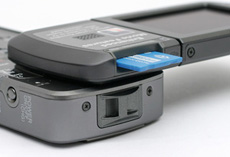 |
| Click images to enlarge. | |
With the LCD monitor flipped open, we can see the Memory Stick Duo Pro media slot, which accepts regular Duo as well as Pro Duo cards. The M1 comes with a 32 MB Duo card, but we recommend upgrading to something larger, since the 32 MB card will only hold a handful of 5 megapixel images or short video clips. From this angle, we can also see the post for the included wrist strap.
The bottom of the camera features a metal tripod mount as well as a rather flimsy plastic sliding door that conceals the battery compartment.
The Sony M1 uses the included NP-FT1 rechargeable Lithium-Ion battery (3.6V 680mAh).
On the right side of the camera is the main power button. However, the camera can also be turned on by simply rotating the LCD monitor to its open position. From this angle, we can also see the labels next to the lamps, which indicate the current camera mode.
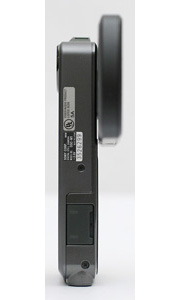 |
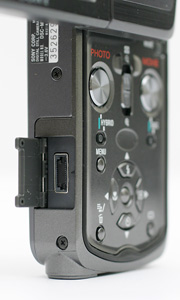 |
| Click images to enlarge. | |
On the left side of the camera is a plastic hinged cover that protects the multi-connector. The multi-connector is used to connect the camera to the charging dock. You may have noticed that there are no USB or TV-out ports on the camera. These ports are both located on the charging dock. Therefore, you must have the camera "docked" in order to use either the TV-out or USB functionality.
The Sony DSC-M1 is certainly an interesting camera because of its unusual design. We are glad to see that the body is made of metal, which gives it a rugged feel in our hands. Handling the camera takes some getting used to as it is very easy to block either the lens or AF-assist lamp if you aren't careful with your fingers. With the physical design out of the way, let's take a look at some of the recording capabilities of the M1.


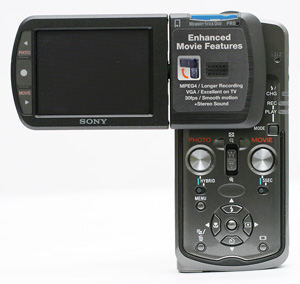

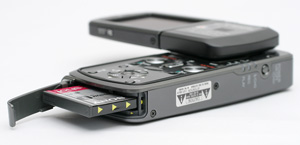









21 Comments
View All Comments
Gatak - Thursday, June 23, 2005 - link
#14, #11:My mistake. I read up on the NTSC standards. Originally they wanted 60Hz to avoid interference from the 60Hz power lines and also to use as syncronization for some camcorders. But they later choose 59.94Hz. The old b&w TV was 60FPS though.
Still, 59.94 or 29.97Hz seem strange to me. Converting a 24FPS FILM source would work just nice to 30 or 60FPS. (24x1,25=30, 48x1,25=60). The whole concept of using telecine is horrid to me:
1) reduce speed from 24fps to 23.976fps
2) split frames into fields
3) insert one new field every 4 fields.
4 playback with jerkiness!!!
Why not keep the 60Hz and at least remove step 1 in this list?
At least with PAL you would only have the first step, although they use 4,17% speedup instead. Some say it is worse, but I think it renders motion a lot better. Not to mention the almost 20% better resolution of PAL.
Locut0s - Wednesday, June 22, 2005 - link
My original quip about "multi-use" products could probably use a little clearing up. I am not against the idea of a product that integrates more than one feature. And in fact there are examples of products that I own that do just that and that I am happy with, like the printer/scanner/copier here. However my experience is that more often than not features are tacked onto products not to add another good feature but to add another line to the "features" list for marketing. I too would be happy with a video camera that takes sub par but still very good stills. But more often than not you end up with a video camera that not only takes sub par stills but they are blury and the feature seems like an afterthought, barely integrated with the rest of the features and cumbersome to work with in the software.PrinceGaz - Tuesday, June 21, 2005 - link
I'm cool with devices that do more than one function, but they must do every function well else in my opinion it is a non-function. So for instance the nGage which combined a baadly designed game console, with a cumbersome mobile phone, and a poor PDA, failed on every count and deservedly was a total flop as basically it was a device that did nothing well.A decent camera that takes substandard video-clips is fine by me, as it is still a camera and that is what I want from it. Similarly a camcorder with substandard still-image shooting (like the DSC-M1 reviewed) is still a camcorder and tbh I wouldn't really expect it to rival the still-image picture quality of a dedicated high mega-pixel camera. Oh sure it would be great if it did, but that's not of any real concern. It may have been best to review the DSC-M1 from the point of view of it being a camcorder, with higher resolution still image shots as just an extra feature. It certainly looks like a camcorder.
As for batteries, like I said I prefer AA's but as others have mentioned, they are larger because you generally need two to four to power most gadgets. I see NiMH AA capacities of 2400mAh are now readly available so thy continue to rise. Another reason to favour AA cells- as battery technology improves, you can get longer life cells cheaply. Certainly beats paying £30/$50 for some proprietary battery that is only available from the product manufacturer.
SDA - Tuesday, June 21, 2005 - link
Like johnmcl7, I prefer AAs. Definitely bigger, but they offer better battery life, and it's a lot cheaper and easier to replace dead NiMH AAs than dead proprietary Li-Ion batteries. Remember, Li-Ion batteries have a hard three-year limit on useful lifetime even if they're not used at all.. kind of sucks if they haven't been made in a while.I don't really care how many things a device does so long as it's reasonably good at all or most of them. Problem is, that doesn't hold true for a LOT of gear. Not that it doesn't for this, of course.
GoatMonkey - Monday, June 20, 2005 - link
It's pretty narrow to think that you should need a separate device for everything. Why should you? You can share common storage and batteries easy enough. You can share a common LCD screen and most of the control buttons. You can share a common CPU between the devices. Maybe if they would start to see these devices as small scale computers instead of just a camera, just a video recorder, just a phone, just an mp3 player, just a PDA, just a GPS...I don't see a reason that you can't have a device that is a common platform for each of these things where you could just attach the physical pieces that you want or need. There is no reason that the physical devices even need to be attached to the central platform if you're using Bluetooth, or whatever its successor is, Bluetooth 2 maybe?
I imagine an mp3 player that plays to a wireless bluetooth headset. Maybe that wireless headset could actually contain a processor a camera lense. I hate to say it, but I think people are going to be walking around looking like Borgs in about 3-5 years.
Johnmcl7 - Monday, June 20, 2005 - link
#9 - That attitude is just a bit daft, why limit devices to one function when they are capable of more than that? The expectation with combination devices is that they must be able to replace all the separate devices of which they attempt to offer the functionality of. I don't see it that way, I don't think my digital camera offers anything like the quality and functionality of a proper video camera, however I don't expect it to either - I'm glad to get some video capability, which is acceptable for me without having to carry another device with me.On the subject of batteries, I prefer AA batteries where possible, although on small cameras they can increase the size quite a bit. I went from the proprietary li-ion battery on the Fuji 4900z to 4xAA batteries in the S7000, it significantly increases the size and weight of the camera but it lasts far, far longer plus it's great being able to use any batteries, when I run out of power and really need some batteries I can just pop into a shop and grab some. Have to say, I'm very impressed with the battery in the Canon Ixus 500, it is a propietary battery but unlike other compact cameras I've used, the batterylife is surpsisingly good, I thought I would have to charge it up often but I only have to charge it occasionally, it's great that's always ready when I need it.
John
xt8088 - Monday, June 20, 2005 - link
#10, that's the standard frame rate for NTSC TV stanard(North American, Japan, Taiwan and etc use it).xt8088 - Monday, June 20, 2005 - link
Though, the Li-ion battery is smaller and lighter, that's more important for smaller P&S cameras.xt8088 - Monday, June 20, 2005 - link
#8: I agree. I was trying to say something like that. Proprietary Li-ion battery is way too expensive. But the calculation of capacity is more just mAH. You need to multiply the Votage to get correct capacity. 3.6V 680mAh 3.6V 680mAh almost the same as 1 NiMH AA 2000mAH@1.2V. Anyway, 2 or more such AA batteries have much more battery life than the proprietary one.stephencaston - Monday, June 20, 2005 - link
Gatak, yes this is the original video straight from the camera. I agree on your FPS concept...I would hope that advanced features like that are available in future MPEG4 cameras.